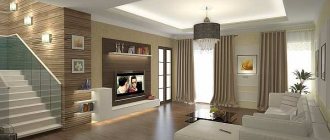When building a private house, each owner must take into account the standardized height indicators for premises for various purposes. But the height of the ceilings is of interest not only to home owners, but also to apartment buyers, because the comfort of living, as well as the field for realizing design ideas, depends on this. Height standards differ depending on the timing of the construction of the building and its purpose.
From the article you will learn what is the optimal distance between the floor and ceiling in an apartment, as well as what height of flow in the bathhouse is permissible.
Standard ceiling heights
The main regulatory document regulating the height of ceilings in apartment buildings is SNiP 31-01-2003, according to which the parameter in question depends on:
- Climatic conditions in a particular area;
- Purpose and type of room.
Climatic region is a parameter that takes into account the average temperature profile for each month, as well as the level of humidity and wind direction. According to SNiP 01/23/99, there are four districts divided into 16 zones. The zones are arranged in descending order - the higher the category, the milder the climate in this zone.
According to the standard, in the warmest zones the ceiling must be at a height of at least 2.7 meters, and for other areas the minimum ceiling height is 2.5 meters. These parameters are not formed out of the blue - complex calculations show that ensuring a normal microclimate and air exchange in rooms is possible only if the actual parameters correspond to the nominal ones.
In rooms located in the attic, the ceiling can be lowered, but the amount of reduction is also regulated - the ceiling level can deviate from the standards only over half the area of the room. In passage rooms (for example, corridors), the ceiling height according to GOST can be reduced to 2.1 m - this figure will be quite sufficient for the normal movement of people.
The maximum ceiling height is not specified by regulatory documents, but in practice the ceiling is rarely raised above 3.2 meters. In older buildings, the size of the rooms can be increased, as a result of which the ceiling height can exceed 4 meters.
When arranging your home yourself, you need to choose the ceiling height taking into account the parameters described above and the area of the premises. For example, for small and narrow rooms it is not recommended to use high ceilings - they will create a rather unpleasant feeling. In large rooms, this rule works in the opposite direction - for a large hall, a ceiling over 3 meters high is optimal.
The poor cry too
- How to increase the height of a room in an apartment building?
Here are a couple of the most obvious solutions:
- Remove the wooden flooring along with the joists. It will allow you to win at least ten centimeters. To level the slab floor, use a self-leveling floor; for sound insulation, use linoleum with insulation or laminate with a thick (5-10 mm) and dense (for example, cork) backing;
Removal of flooring and joists.
- Remove the screed poured onto the ceiling. Its typical thickness is 5 - 8 cm. On the first floors, under a reinforced screed, a layer of insulation 3-5 cm thick is often laid; in this case, the ceiling height will increase by an impressive 8 - 13 cm.
Dismantling the screed.
Of course, after removing the insulated screed, you will have to seriously worry about insulating the basement under the apartment.
- How to make a room taller in a wooden house?
And here I will offer you a couple of ideas:
- Hem the ceiling not along the beams, but along the cranial bars stuffed onto their side surfaces;
The clapboard hemming is made not along the beams, but between them.
- Cut out the floor beams and lay an insulated screed on the ground on top of the concrete preparation (a layer of low-grade concrete).
In the latter case, window and door openings will rise noticeably relative to the floor level. Be prepared to cut out an additional crown and replace window and door units.
Thanks to the underground floor, you can gain up to half a meter in height.
- How to visually increase the height of the ceiling if it is not possible to physically raise it?
Play with contrast. Human vision has an interesting feature: light objects seem more distant to him than they actually are, dark objects seem closer. If you paint the ceiling white or just the lightest possible color, it will seem higher to you; the effect can be emphasized by decorating the walls with a dark finish.
The opposite is also true. A dark ceiling with light walls will look lower than it actually is.
A couple more tricks:
- Tall baguettes, moldings or simply white stripes at the top of the walls will further increase the apparent height of the ceiling;
A white ceiling with a wide snow-white baguette will appear higher.
- Gloss and, in general, any finish that has a mirror effect will work in the same way. All surfaces that fully or partially reflect the interior of the room will deceive your vision and make the ceiling surface appear more distant than it actually is.
The picture clearly shows how gloss affects the apparent height of the room.
Bathroom. The ceiling is decorated with mirror tiles.
- How to visually increase the height of the ceiling if major renovations to the room are not planned?
Lighting affects the visual perception of distances in the same way as light finishing colors. By brightly lighting the ceiling with relatively dark walls, you will again make it higher. For this purpose, you can use spotlights, spot lights or a bright LED strip hidden behind the ceiling plinth.
The illumination is made by LED strip laid on a baguette.
"Stalin" and older houses
Older buildings traditionally did not skimp on space, so the area and height of each individual room was quite large. The thing is that the historical period in which such houses were built was not characterized by the desire to provide all families with at least a small apartment.
The ceiling height standards in "Stalinka" buildings vary from 3.3 to 3.6 m, while the ceilings themselves are usually decorated with various decorative elements - for example, stucco molding or cornices. When installing suspended ceilings in such apartments, due to the large amount of finishing, it is necessary to significantly reduce their level.
Certain difficulties also arise due to the fact that wooden elements were often used to make floors in old houses, and the wiring was laid externally - repairing the ceiling in such conditions is not very easy, so you have to invest much more money in repairs.
However, an increased amount of free space has its advantages - in a tall room with a large area, you can arrange any style, and it will look quite appropriate. An excellent option, for example, would be a multi-level suspended ceiling, decorated with a variety of decorative elements.
Suspended ceilings of any configuration are generally very suitable for rooms with a high ceiling height - the availability of space allows you to painlessly reduce the volume of the room. Finishing the very basic ceiling in such rooms would be a bad decision - the existing ceilings usually have a lot of “congenital” defects, which are very difficult to hide.
How to adjust a room if the ceiling is low
The parameters of the room should be such that it is pleasant to be in it. For example, in a high and narrow room a person may feel uncomfortable because he will have the impression that he is in a well. There are several important parameters that would help ensure this comfort.
Visual techniques
There are many ways to elevate it using the right materials, colors and design techniques.
Mirror surfaces
Nothing will help visually enlarge a space like a mirror. However, we do not recommend getting carried away and covering all surfaces with mirrors; this will simply make the space uncomfortable. Try combining ceiling tiles with mirrored or highly reflective glossy inserts.
Color
Here, follow the rule that the ceiling surface is lighter than the walls. For small rooms, light pastel shades are well suited; they not only refresh the appearance of the room, but also visually expand it.
Pexels
Another little trick: think through your interior so that the colors gradually lighten as they rise from the floor to the top. For example, from a dark gray floor there is a transition upward to cool white.
Wallpaper
Here you need to try to find a wall covering with a vertical pattern. These can be stripes, floral patterns or painted branches. Give preference to light tones of wallpaper with a slight shine.
Try experimenting with a matte texture on the walls and a glossy texture on the top floor. In this case, the color of the surfaces must be the same. It is worth noting that if your ceiling height in your apartment is only 250 centimeters, then we recommend forgetting about decorative borders and baseboards. They tend to delimit space, thereby shortening it.
Interior items
It’s worth paying attention to the furniture, because correctly placed accessories, just like materials, affect the visual perception of the room. Install tall shelving and cabinets. This will become a significant accent that will stretch the room. Also choose sofas and armchairs with low backs.
Unsplash
Little things matter too. Place thin vases, small trees, folds in curtains on the shelves - all this stretches the vertical of the room and helps to raise even a low ceiling.
Little things matter too. Place thin vases, small trees, folds in curtains on the shelves - all this stretches the vertical of the room and helps to raise even a low ceiling.
Tips for creating a pleasant atmosphere
Microclimate
Humidity and temperature should be comfortable and pleasant.
- Cleaning
9 rules for a healthy microclimate in your home
Lighting
There should be a lot of light in the room, be it natural or artificial lighting. It’s better to have a lot of light elements that can be turned off and on if necessary.
Ventilation
The supply of fresh air is a very important element that affects the comfort of staying in the apartment.
"Khrushchev"
During the reign of Khrushchev, serious changes occurred in the construction industry. Thus, the main task set for the developers was to provide all families with their own housing. Of course, with such introductory housing, it was necessary to seriously reduce the housing, and the result of the design work was the “Khrushchev” - apartments with a very modest area and minimal ceiling height.
In classical apartments of the period under review, the ceiling was 2.5 m from the floor level. Individual apartments located on the first or last floor could have ceilings 0.1 m higher than the designated indicator. In the northern regions, the height from floor to ceiling in an apartment could reach 2.7 m.
For the manufacture of interfloor ceilings in Khrushchev-era buildings, reinforced concrete panels were used, which are easy to construct, quite reliable in operation and can be faced without problems. Accordingly, finishing ceilings usually came down to processing the joints in the slabs and applying whitewash.
Stretch ceilings, despite the reduction in ceiling height (even the simplest structures “eat up” about 5 cm), are used quite often in Khrushchev-era buildings. Lath or plasterboard structures are much less common - they require much more space to install. There is no need to talk about multi-level structures - they are completely inappropriate in such conditions.
By installing a suspended ceiling, you can try to compensate for the loss of free space by visually expanding the room. To achieve this effect, you need to very wisely select the colors and texture of the ceiling structure. It is better to use spotlights as lighting devices - installing large chandeliers in Khrushchev buildings is completely impractical.
Color and lighting solution
With a low level of overlap, the problem is solved by choosing a color. For example, a mirror ceiling or glossy canvas will visually increase the height of the room. You can raise the structure by painting the surface in cool light colors (light green or bluish shades). A stretch fabric of contrasting colors will allow you to zone the room; correctly selected shades will visually raise the ceiling.
The right design furniture will allow you to raise the level of ceilings. Dark lower cabinets and upper shelves made in light colors will increase the verticality of the room. The ceiling framed around the perimeter by an LED strip will appear higher.
Illumination with spotlights mounted correctly into the surface of the coating will increase spatial perception.
When choosing a new place of residence, you need to pay attention to the height of the ceilings, but it is worth noting that you can visually change your spatial perception by knowing little secrets about the design of the room.
"Brezhnevki"
After some time, when Brezhnev came to power, along with him came the desire of people to live in more comfortable conditions. This desire is reflected in state building regulations. Thus, the standard ceiling height in an apartment has increased to 2.6-2.7 m, and the rooms themselves have become larger. In addition, standard designs were supplemented with separate hallways, as well as built-in wardrobes and mezzanines. There were no other differences from the apartments of the Khrushchev era - all the same brick walls, panel ceilings, simplified layout and complete absence of any decoration.
Brezhnevkas are quite convenient in terms of repair. The ceilings in such apartments are simple and fairly flat, which allows you to use any available materials and solutions for finishing. The difference between the base ceiling and the minimum possible is about 15 cm - and this distance is quite enough for both simple finishing and for arranging suspended structures.
When you're not happy with the height
Sometimes it is necessary to change the height of the ceilings in an already finished house, and for this they use different techniques. In order to make the room a little more squat, the following methods are suitable:
- Suspended and tensile structures are still relevant. The design can be anything: multi-tiered, illuminated, with the interior trimmed with wood or other contrasting material.
- The ceiling can be turned into an accent surface, made bright, or vice versa, dark, contrasting with the rest of the interior. The easiest way is to use paint or wallpaper.
Beams make a room more comfortable Source initial.com.ua
Buildings made of panels and blocks
Initially, panel houses were built under Khrushchev. The standard configuration of such houses assumed that they would have five floors, and they would be built in the southern regions. The standard ceiling height in panel houses was about 2.5 meters, and the walls were built of brick. By and large, these buildings were very similar to typical “Khrushchev” buildings - there was little free space, and there was not enough natural light even on sunny days.
Renovation of houses made of panels and blocks occurred already in the 80s. The new buildings were distinguished by an increased number of floors, large area of premises and high ceilings - their minimum height was 2.65 m, and in some cases reached 2.75 m. Even with a superficial examination, we can safely say that such apartments were much more convenient.
This convenience was evident not only during the operation of the apartments, but also during renovations. Thus, finishing the ceiling was extremely simple - initially the surface of the floors was flat, so it could be arranged in any way. The high ceilings typical of such apartments made it possible to use suspended and suspended ceiling structures.
The most noticeable disadvantage of panel houses is the low level of sound and noise insulation. That is why during renovations it is always necessary to use high-quality materials to reduce the noise level entering the apartment from the outside.
Pros and cons of different ceilings
The optimal ceiling height in a private house is an average value. If the task is to build comfortable housing without much sophistication at minimal expense, the most correct solution is to follow standard dimensions. At the same time, the standard dimensions of 2.6 meters easily avoid many disadvantages and make life in the house pleasant for its inhabitants.
A private house
High ceilings
They have their disadvantages:
- Costs during the construction phase of the building will be higher. This also entails increased costs for interior decoration.
- Complex organization of the heating system, the operation of which will require significant funds.
- Increased complexity of repair work. Repairers will be forced to use special structures. This entails an increase in the cost and time of repair work.
- Difficulties that occur in everyday life. A special approach is required when servicing and cleaning the premises. Even replacing a light bulb can cause difficulties.
Pros:
- They contribute to the formation of a specific atmosphere and a feeling of spaciousness.
- Lots of room for imagination when decorating. Such ceilings contribute to the creation of an individual floor design; it is possible to use several levels using various decorative solutions from plasterboard. They are perfect for the Baroque style, which involves the presence of a variety of stucco moldings, as well as for the classics.
Standard project
Experts recommend decorating a space with high ceilings following the “rule of three” - the walls are divided into three sections. The lower level is intended for auxiliary decoration, the middle level is occupied by shelves and paintings.
It is not recommended to place paintings below eye level, otherwise there will be a feeling of emptiness. The last section of the wall, the top, is left empty. This breakdown allows you to visually raise the ceiling level even more. For lighting it is recommended to use large chandeliers. Thanks to them, the room will become elegant and chic.
Low ceilings
Pros:
- They create a feeling of pressing overlap, which causes discomfort from staying in the room.
- It is impossible to use large chandeliers, especially in relation to a ceiling 2 meters high - a large chandelier will create an unfavorable environment.
- Restriction on decorative design - a multi-level ceiling will be irrational. Its creation is accompanied by difficulties, and its implementation in practice is only possible when turning to highly qualified specialists.
Ceiling height in a private building
The advantages of low ceilings lie in the disadvantages of high ones; it makes no sense to dwell on them in detail. When designing a room with low ceilings, experts recommend abandoning the following elements:
- lampshades, massive floor lamps;
- stucco on the ceiling, the use of volumetric decorative elements;
- large wardrobes, high tables and bulky sofas;
- Painted curtains fixed directly to the wall are suitable for ordinary ones - plastic ones fixed to the ceiling.
Designers believe that it is better to focus on the texture and color of the room. A good solution would be to use white as much as possible. This color helps to visually increase the space.
Hallway
The walls and ceiling can be decorated using shades of white. When decorating the interior of a room, it is preferable to use mirrored, glossy materials. Reflective surfaces also help to visually increase the cubic capacity of the room. The best solution is a glossy stretch ceiling.
Modern apartments
Today, apartments and premises in multi-storey buildings have a variety of layouts, and modern technologies are used in the construction process. Due to this, a fairly wide variability in the dimensions of the premises is ensured - for example, the height of the ceilings in the office can completely “float” depending on the purpose of a particular room. Diversity allows you to choose apartments in a wide range of prices - with a minimum budget you will have to choose among economy-class apartments, and the ability to invest more money allows you to purchase housing that will have a larger area and a high degree of comfort.
The difference between cheap and expensive apartments is obvious:
- When building small apartments and studios, the priority goal is the minimum cost of finished housing. One of the ways to save on materials is to limit the height of the ceiling, so the standard ceiling height in new buildings is usually the minimum allowable 2.7 m. The ceiling itself in such conditions lends itself to any finishing work - the only limitation is multi-level suspended structures, which are undesirable to install in small rooms . The optimal solution would be to use finishing materials that allow you to visually expand the space.
- For the construction of expensive apartments, individual projects are usually used, and the ceiling height in new buildings can vary from 2.8 to 3.2 m. The purchase of luxury housing usually indicates the good financial capabilities of the buyer, so all repair and finishing work in this case is entrusted to the appropriate specialists. A competent designer will calculate the optimal ceiling height for a specific project, which will fit perfectly into the planned style.
Briefly about the main thing
The standard ceiling height is determined by many reasons: the area of the house and premises, the region of construction, the purpose of the rooms, and an understanding of comfort. However, in different eras its meaning fluctuated in different directions under the influence of external circumstances.
In addition to the standard, balanced ones, there are high and low varieties of height, each with its own advantages and disadvantages. As a rule, the final solution is chosen for reasons of prestige or economy. You can bring the ceiling height closer to the standard one by visual means, using a play of color and pattern. Suspended and tensile structures and various decor (beams, stucco) will help make the room lower.
Private houses
In the case of private houses, everything is somewhat different than with apartments. When building apartment buildings, developers have to take into account the fact that there will be many apartments in one building, and each of them needs to be made quite comfortable - i.e. certain restrictions are introduced. For private houses, such restrictions are irrelevant - the dimensions of the premises are practically independent of external factors.
For a comfortable stay in a private house, you need to raise the ceiling to a level of about 2.9-3.2 m. Of course, these figures can be increased even more, but this is impractical - the free space will not be in demand, and heating costs due to the increase the volume of the room will increase. In warm regions, this point can be ignored, but for the middle zone and northern regions it is more than relevant.
The selection of finishing materials for the ceiling directly depends on how the floors were formed:
- In the case of wooden beams, tensile and suspended structures are best, as well as wood cladding and materials that allow the beams to remain visible;
- Absolutely all finishing materials are suitable for reinforced concrete floors.
Creating an ergonomic kitchen space
When planning the installation of a kitchen set, it is important to take into account not only the general concept of the interior, the choice of style and color scheme, but also the ease of use of cabinets and cabinets. It is important to think about how comfortable it will be to open the facades and pull out drawers; will nearby objects interfere with this? Will it be convenient to use a single-level work surface or is it better to use a different height for each zone?
The placement of shelves and drawers should be thought out. For example, at a height of 400 mm from the floor it is better to store items that are rarely used, as well as massive things, since the space there is not comfortable for viewing. A distance of 750 mm is suitable for household appliances and drawers with large dishes. The height of 1900 mm from the floor is ideal for easy viewing, so here you can place everything that is constantly used in everyday life: spices, dishes, cutlery. Above this distance, you can place shelves for storage, but using them every day will be inconvenient, since you will have to constantly substitute a chair to reach the desired item.
It is best to place the stove or hob in the central part of the kitchen unit. Its placement near the window and close to the aisle is not very convenient, and it can also be dangerous. It is better to maintain a distance of at least 400 mm between the stove and the sink and use it as a work surface.
Designing a kitchen unit is not an easy task. It requires not only an aesthetic approach, but also a practical one. In order not to rack your brains over complex issues of space ergonomics and choosing the most convenient furniture dimensions, there are certain standard sizes. Thanks to them, you can comfortably use shelves, drawers, built-in household appliances and other necessary items.
Ceiling height calculation
It’s worth noting right away that the height of the ceiling in a living space and its decoration are two closely related parameters, and each of them depends on the other. For this reason, before calculating the height of the ceiling, you need to decide what finishing materials will be used in the structure. Knowing this parameter will significantly simplify the calculation of the ceiling height, especially if systems consisting of several levels will be mounted on it.
The standard ceiling height in an apartment is a fairly clear parameter, and for each of the existing types of housing it was described above. But, in addition to this parameter, there is also an optimal ceiling height, which always exceeds the standard or coincides with it. Calculation of the optimal height is aimed at ensuring that each room is as comfortable as possible and looks harmonious.
When choosing the optimal ceiling height, it is worth considering the following number of factors:
- In residential premises and kitchens, the minimum height of ceilings in an apartment after all work must exceed the height of the tallest family member by 1 m. This indicator was not derived by chance - studies have shown that the highest content of various harmful impurities of household origin is observed at this height. To eliminate the impact of these impurities on the body, you need to raise the ceiling level in accordance with the specified rule.
- Making ceilings that are too high is not practical from an economic point of view. For example, if in a building with an area of 100 m2 the ceiling is raised by 30 cm, then the total volume of the house will be increased by 30 m3 - and this volume will not be useful, and a significant amount will be spent on heating it.
- In multi-storey private houses, high ceilings are not recommended. Firstly, this will lead to an increase in the cost of heating and the cost of building a house. Secondly, if there are two or more floors, it is necessary to equip a staircase - and if the ceiling is too high, it will be located at a large angle, and because of this it will not be possible to walk comfortably on it. To make a large and spacious room, it would be better to plan the house so that there is no ceiling above this room at all.
- In non-residential and utility premises, a high ceiling is completely unnecessary. In a closet, small hallway or garage, the ceiling height may be below the minimum. Typically, for such premises, values of 2.2-2.5 meters are used. In bathhouses and saunas, the ceiling rarely rises above 2.2-2.3 m - when this value increases, it becomes much more difficult to heat the room.
- There is a direct relationship between the area of the room and the height of the ceiling in it - the larger the room, the better the high ceiling will look in it. To ensure that the ceiling height in the apartment corresponds to the area of the premises, you can use various finishing methods that change the height of the structure - for example, suspended or stretch ceilings. Such systems, among other things, also allow you to hide all communications.
How to adjust a room if the ceiling is high
Surprisingly, this is sometimes necessary. For example, in small rooms, high walls create the feeling of a well. And I want to avoid this. We recommend several working methods.
Multi-level
With the help of various protrusions, steps, convex parts and inserts, you can give the room not only an interesting and original look, but also reduce the space a little.
Tensile structure
Pexels
This method is not recommended for apartments where the vertical length of the walls is only 2.5 meters. The reason is simple: the structure is made with an indentation from the ceiling at a distance of 5-20 centimeters, since communications and sound insulation are located inside it. But for high ceilings and small rooms it is a good solution.
Plasterboard structures
This type also requires a setback from the main floor, which means it reduces the height. First, determine the degree of curvature of the surface of the concrete slabs. A ledge is made on top along the perimeter of the room, and LED lighting is placed under it. Pay special attention to it, since in the future it will be important what size the lamps are and the amount of wiring. Sufficient space must be provided for convenient installation and subsequent operation. Another aspect will be the shape itself. Drywall can be used to give the top floor a lot of interesting shapes. Therefore, design the number of levels in advance.
However, you need to be careful with this method so as not to make it even worse - the design can take away from 15 to 20 centimeters.
Pixabay
Or, as another interesting option, make a glossy or mirror insert in the middle, where there is no structural box. Thus, in contrast with the protrusion, this element will appear higher, and due to the reflection of light, the space will visually increase.
Rational ceiling height
Any owner, when starting to build a house, wants to determine what ceiling level will be optimal for each of the rooms of his house. This approach seems quite natural, because after the construction of the building is completed, it needs to be inhabited - which involves maintenance and care, so it will not be possible to limit oneself to just enjoying the beauty of the structure. Comfortable ceiling heights are determined from the following principles:
- own wishes;
- taking into account ergonomic rules and regulations;
- standardized building dimensions.
Drawing and section of a private house
Personal wishes regarding which height will be more comfortable are quite diverse, and this issue does not require detailed consideration.
It is necessary to first familiarize yourself with the ergonomic side, at least with the most basic nuances.











